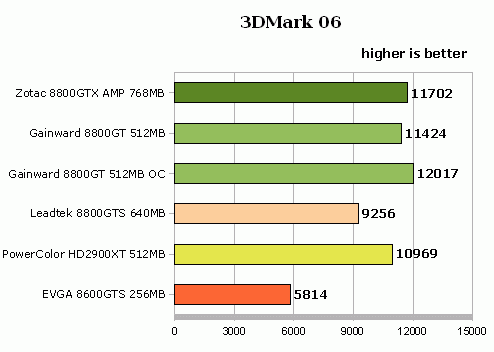Geforce 8800 GT is a card that got everybody talking weeks before it came out, and after the first reviews it has become a card that many users desire. The stock shortages are a problem; but they'll soon be solved, and the only question left is whether this is the card for you. Performance wise, ATI can’t match Nvidia’s offer, but ATI will play the price card and offer their RV670XT at a lower price. However, performance wise it could not get close to Geforce 8800 GT.
On the other hand, Nvidia will play a somewhat dirtier game – better Geforce GT versions are almost ready. Geforce 8800 GT 256MB will definitely lock horns with RV670XT, and as we’ve seen in the past couple of days, you can already pre-order it in Great Britain for £30 less than its 512MB version.
Until then, we’ll work with what we’ve got, and that’s the MSI NX8800GT-T2D512E-OC graphics card. Under its hood you'll find a G92/D8P chip with 721 milion transistors, which is more than 8800 GTX has.
MSI NX8800GT-T2D512E-OC is faster than a reference Geforce GT card, and it’s unlikely that the new Flextronics cards will boast much better clocks. As you probably know, all currently available Geforce 8800 GT cards were manufactured by Foxconn, and you can read more about that here.
If you look at the specs, you’ll see that our claims of MSI NX 8800 GT being faster than reference design cards were justified. Its core runs at 660MHz, which is 60MHz more than stock speed, Shader Stream processors at 1650MHz - 150MHz faster than stock, and the memory at 1900MHz - 100MHz is faster than stock. So, MSI didn’t put OC in the name just for fun, the card has actually been overclocked.

Hardware wise, MSI NX 8800 GT is no different from reference cards or our recently tested Gainward Bliss 8800 GT card; this card features the same cooler and PCB. The only thing that sets it apart is the MSI sticker. The cooling fan is quiet until it reaches maximum RPM. One 3x2 power connector hidden in the back of the card will be enough to power this card.

Geforce 8800 GT (G92) with Qimonda HYB18H512321BF-10 graphics memory.
The G92 graphics chip is manufactured in the 65nm production process and its TDP is about 110W. Although the chip is small in size, it’s got more transistors than the G80, 90nm chip on Geforce 8800 cards. G92 core dimensions are 18mm x 18mm, or 324mm², which is quite a lot for a performance chip.
As we’ve seen before, this card is better than the Geforce 8800 GTS; even when compared to the Geforce 8800 GTX, it still holds its ground. Geforce 8800 GT cards feature 112 Stream processors, 8800 GTX features 128 and 8800 GTS features 96. Although the number of Stream processors would suggest that GT is better than GTS, that is not the case. In the graphics pipeline, number of ROP units plays an important role. GT features 16 of these, GTX features 24 and GTS has 20. 8800 GT’s ROP compression algorithms have been optimized, and when it comes to texture addressing, it beats G80. You can address 8 addresses per clock,a whereas G80 could only address 4. In the end, you get a number of 56 texels per clock (7 clusters times 8 texels per clock), which is much more than 8800GTS (24) or 8800GTX (32) can offer.
Since we’ve mentioned that Geforce 8800 GT has seven open clusters, we can’t exclude the possibility that Nvidia deactivated the eighth and that they could activate it if there’s need for it. With their RV670XT, ATI didn’t quite scare Nvidia into doing this, but you never know. Nvidia divided their Stream processors in Clusters. The 8800 GTX card has 8 clusters, 16 Stream processors each, which adds up to total of 128 Stream processors on Geforce 8800 GTX.
Compared to 8800 GT, G80 has one more advantage, and that’s its 384 bit memory interface. 8800 GT total bandwidth adds up to 57.6 GB/s; 8800 GTS adds up to 64 GB/s; and 8800 GTX adds up to 86.4 GB/s.
The memory bandwidth on MSI's overclocked card is 60.8 GB/s, which is not quite as much as on a G80 card, but numerous improvements and fast core and Shader processors can make this card a fierce competitor, even against 8800 GTX cards.
Geforce 8800 GT’s processor features VP2 (Video Processor 2), something that the G80 didn’t include. This means PureVideo HD support when playing high definition video files, as well as post-processing entirely done in hardware so that the load is taken off the CPU.
Two Dual Link DVI outs with HDCP are natively supported, which means no separate display chip – the option is on the silicone. MSI calls their dual link DVI outs Yellow DVI. They support resolutions up to 2560x1600, and due to the yellow caps that MSI, for some reason, puts on their cards, they’re quite easy to spot. It’s not a bad idea to ensure that dust doesn’t penetrate the second DVI on the card, the one that you don’t use.
Geforce 8800GT is the first PCIe 2.0 supporting card but if you’re counting on DirectX 10.1, and planning a long-term investment, then you must take into account that this card doesn’t support DX 10.1. For casual users, this is not a big deal, especially knowing that most users still opt for Win XP as an OS of choice – and we know that XP supports only DX 9. However, Direct X 10 is slowly becoming a standard, and Nvidia did a lousy job by not including DX 10.1 and Shader model 4.1 support.

MSI sent the card in a retail box, covered with loads of specs and info. Even the picture on the box says a lot. Included in the box you get a 14-day trial version of Lord of The Rings game and a full version of the Colin McRae rally game.

Testbed
Motherboard:
EVGA 680i SLI (Supplied by EVGA)
Processor:
Intel Core 2 Duo 6800 Extreme edition (Supplied by Intel)
Memory:
OCZ FlexXLC PC2 9200 5-5-5-18 (Supplied by OCZ)
while testing: CL5-5-5-15-CR2T 1066MHz at 2.2V
PSU:
OCZ Silencer 750 Quad Black (Supplied by OCZ)
Hard disk:
Seagate Barracuda 7200.9 80GB SATA (Supplied by Seagate)
CPU-Cooler:
Freezer 7 Pro (Supplied by Artic Cooling)
Case Fans:
Artic Cooling - Artic Fan 12 PWM
Artic Cooling - Artic Fan 8 PWM
3DMarks





Higher clocks on MSI's NX8800GT definitely help, and we see that in 3DMark tests, the MSI card is the winner.
MSI's card runs at 660MHz core, 1650MHz Shader and 950MHz memory speed.
Overclocking is not a problem, although the card is overclocked as it is. We’ve had a chance to prove that in our recent Gainward Bliss 8800GT review. However, there are certain cards whose overclocked BIOS won’t work at set frequencies. Thankfully, it’s just the BIOS, which can easily be replaced.
If you want to adequately cool your GPU with the stock cooler, you must override AUTO fan settings and go to MANUAL. The single slot cooler with a small fan will have to run at maximum RPM, and although your ears might not like it – the GPU most certainly will.
When it comes to overclocking, the MSI card didn’t do anything our Gainward BLISS 8800 GT card didn’t. We clocked it to 720MHz and the memory to 1030Mhz. We linked the Shader clocks to GPU frequencies so that they would rise accordingly – which resulted in Shader speeds of 1800MHz for 720MHz GPU.

Take a look at a table below, and it will answer all of your questions. This program makes a quick readout of all the GPU info, and you can download it from Techpower’s website.

Gaming
We used the latest official drivers, and opted for maximum detail settings.




Overclocking provided the Geforce NX 8800 GT with better performance, and it outscored the 8800 GTX with antialiasing off. At higher resolutions however, 8800 GTX is better, but only by a small margin. In this game, the price tag isn’t quite justified. 65nm GPU is overclock-friendly and it makes use of every extra MHz.
![]()




F.E.A.R. can be a bit more demanding, especially at high resolutions where memory plays an important role. The 256bit memory interface exposes weakness, compared to 328bit interface on 8800 GTX cards. Geforce 8800 GTX also has more memory, but 8800 GT still performs well. Even the highest resolution enables smooth gaming. ATI came in close with their HD 2900XT card.
Gaming
We used the latest official drivers, and opted for maximum detail settings.




Compared to Company of Heroes and F.E.A.R., World in Conflict yields significantly lower results. Maximum detail settings severely lower the FPS. MSI Geforce NX 8800 GT is a worthy adversary – it’s right behind Geforce 8800 GTX.
![]()




This game, just like World in Conflict, makes the card work really hard. The Geforce 8800 GT at 1600x1200 with antialiasing and anisotropic filtering on gives you playable FPS. Compared to 8800 GTX, this resolution shows the greatest performance difference so far. In the course of testing, 8800 GTS was always close, but 8800 GT has proven its supremacy.
![]()
Conclusion
It appers that 8800 GT is a great choice and MSI offers two games: Lord of the Rings Online and Colin McRae. The card is overclocked to 660MHz core, 1650MHz Shader and 1900MHz memory. If that doesn’t satisfy your hunger, when overclocked it will run even at 720MHz GPU, 2060MHz memory and 1800MHz Shader speeds.
In this scenario, MSI's card will beat 8800 GTX cards that are far more expensive , and at €250, it definitely proves to be an excellent choice in this price range.
Lack of DX 10.1 support is a handicap, but it won’t be detrimental, at least for six more months. The card will get you a lot of bang for your buck, and it brings awesome gaming capabilities to this price range. We whole-heartedly recommend this card to anyone.



